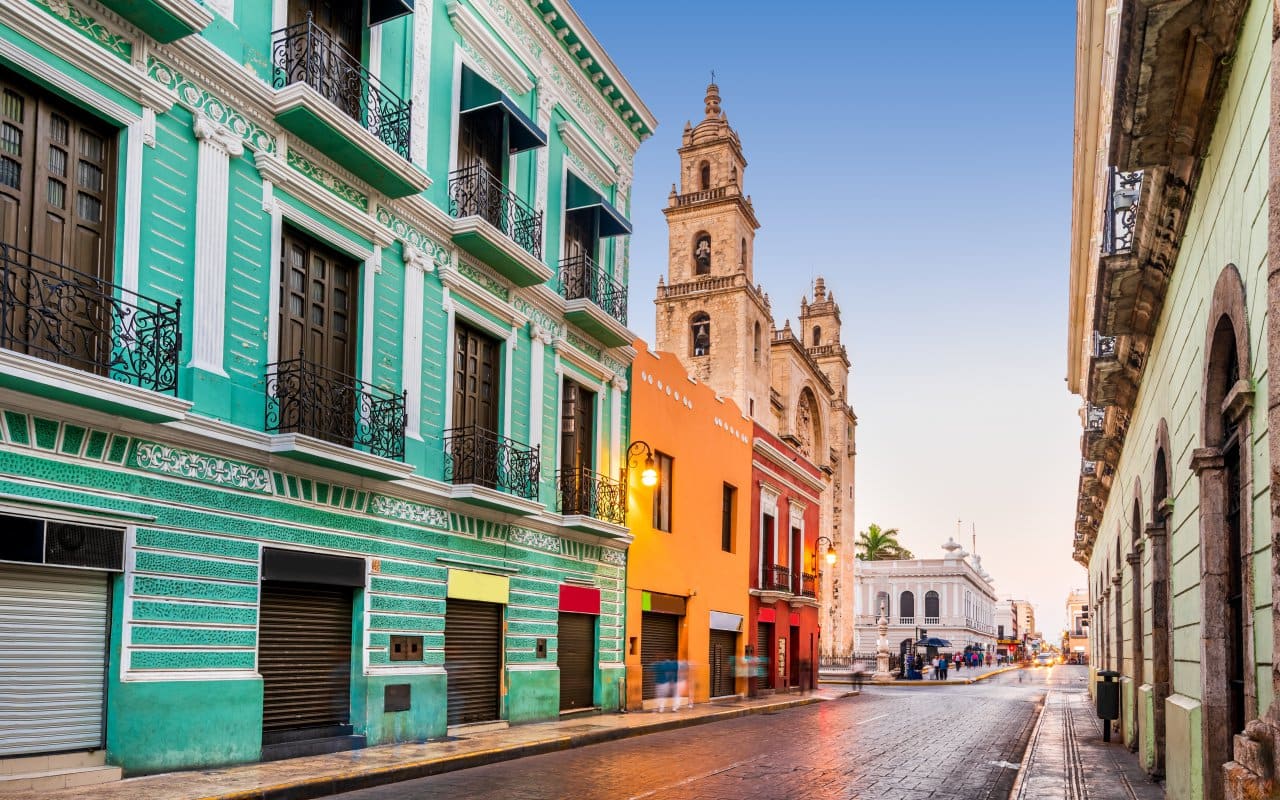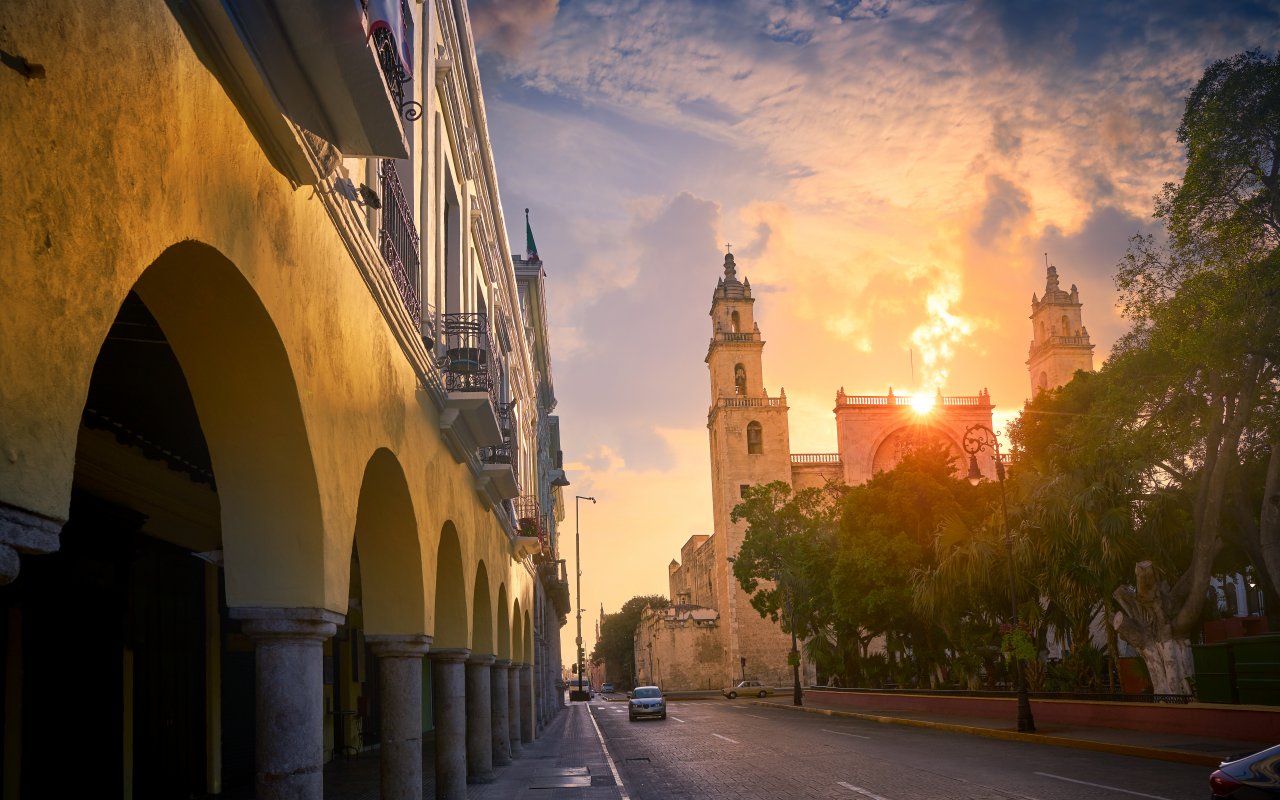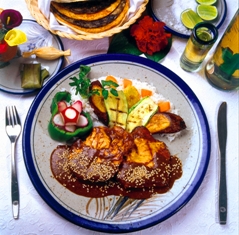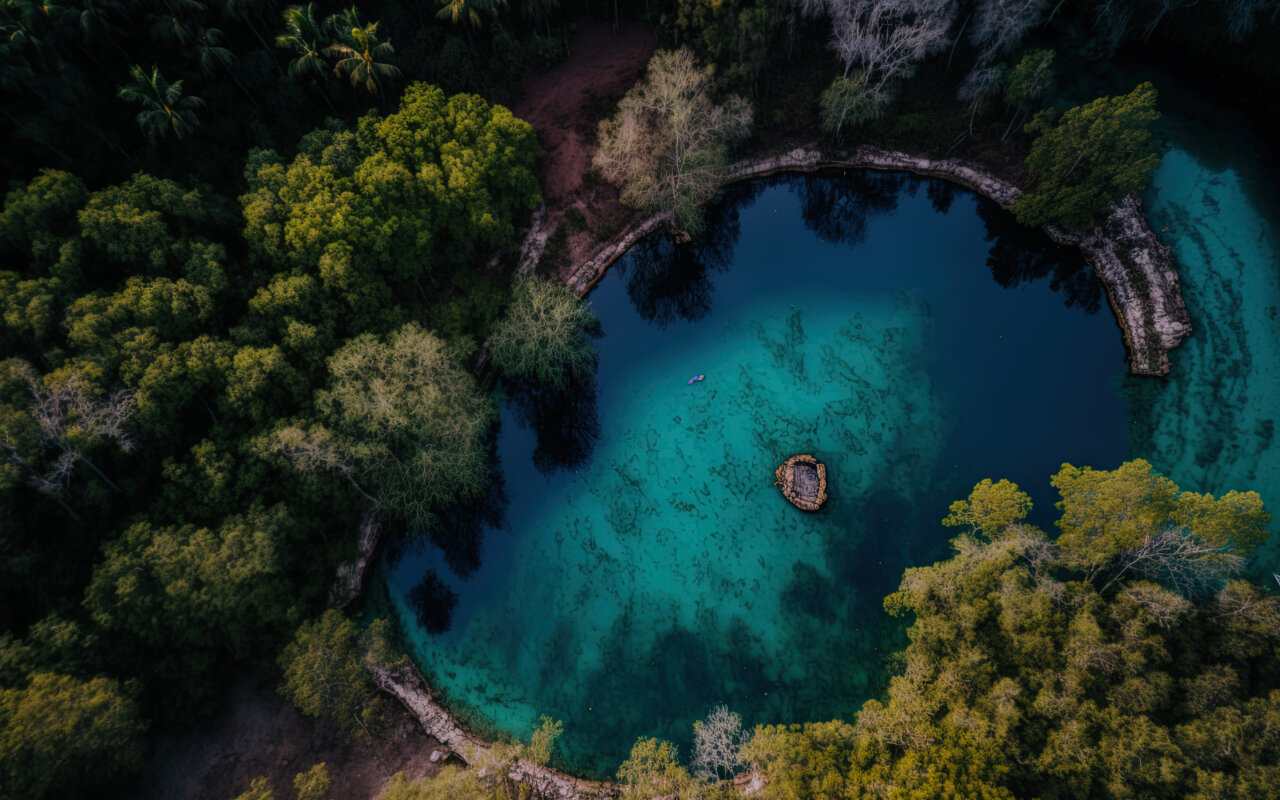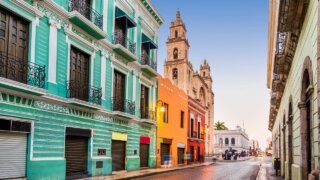Mérida, also known as “the white city”, capital of the state of Yucatán, is located in the north-west of the peninsula. The city attracts visitors with its cosmopolitan atmosphere, human scale and tranquil atmosphere. Indeed, Yucatan’s capital is renowned for its safe streets and peaceful atmosphere. Far from the hustle and bustle and overcrowded beaches of Cancún and Playa del Carmen, Mérida is an ideal stop-off point for discovering southern Mexico. A fascinating, multi-faceted city, it is also ideally located as a starting point for visiting Mayan sites such as Chichén Itza.
Merida, a city with an ancient history
Before it was founded by the Spanish conquistadors in 1542, the Mayan city of T’Ho lay on the site of present-day Merida. During the post-classical Maya era, from the 10th to the 12th century, T’Ho was home to a significant community, which gradually deserted the city before the arrival of settlers. The settlers built the town on the ruins of the ancient city. Francisco de Montejo, sent by the Spanish crown to conquer the peninsula, found an abandoned city where he was able to build one of the largest cities in America at the time, alongside Mexico City and Havana: Mérida. Evidence of pre-Hispanic times can still be seen in the modern city, such as the Cathedral of San Ildefonso, the oldest in Mexico, where in some places carved stones from Mayan buildings can be seen.
During the 17th century, Mérida was fortified to ward off attacks by Mayan troops. Today, many of the gates of this wall still mark out the historic center and part of the city. Later, the city prospered thanks to “green gold”: henequen, a type of agave exported for its ultra-resistant fiber throughout the world in the form of rope and twine. Trade in this precious resource passed through the port of Sisal, a few kilometers north of the city. This golden age is still visible today in the exuberance of the grand houses that grace the city’s main avenue, the Paseo de Montejo.
Colonial Architecture
Today, the center has preserved its original colonial architecture. Like many Mexican cities, the Plaza Grande, the central square or zocalo, is the heart of the city, where residents gather under the shade of trees and where the city’s historical heritage is concentrated. In addition to the aforementioned Cathedral, the Palacio de Gobierno (Government Palace) and the Palacio Municipal (City Hall) are also well worth a visit.
Busy and a little chaotic, with traces of the past around every corner, Merida is a city of colorful facades to explore. Between monasteries and churches, typical little houses and authentic haciendas, the maze that is Merida is full of history.
A thriving cultural scene
Merida is not stuck in the past, however, and boasts a dynamic cultural scene and a number of first-rate institutions. One of these is undoubtedly the Peón Conteras Theatre, the city’s oldest, inaugurated in 1908. With its colonial-style architecture, it is one of Mexico’s most renowned opera houses. It is also home to the Yucatán Symphony Orchestra. Its program includes operas, dance performances, conferences and children’s festivals.
Merida Museums to visit
The Museum of Folk Art showcases the work of artisans in wood, glass and textiles. It showcases the traditional skills of indigenous communities, particularly Mayan descendants.
Macay Fernando García Ponce Museum
The Macay Fernando García Ponce Museum housed in a restored period house, is the only museum on the peninsula devoted to modern and contemporary art. Its permanent collection pays tribute to local artists such as Fernando Castro Pacheco, Fernando García Ponce and Gabriel Ramírez Aznar. It also boasts several rooms dedicated to temporary exhibitions. Its patio, surrounded by lush green vegetation, is a particularly pleasant place to relax in the shade.
Mayan World Museum
To continue the cultural tour, we can also mention the Mayan World Museum, located to the north of the center, or the Casa de Montejo, which belonged to the family of the city’s founders, located on the zocalo. On the other side of the plaza, the Olimpo Cultural Center boasts a planetarium and a wide range of activities and exhibitions for all ages.
This is just a small selection of Mérida’s cultural activities, as the city boasts cultural centers and art galleries for everyone to discover as they roam around. Among them, one not to be missed: La Fundación de Artistas is an organization that opened a center in 2015 to promote contemporary creation on the Peninsula. In the evening, the atmosphere changes! In the center, the traffic calms down and gives way to concerts here and there, while onlookers stop, sometimes venturing to draw a few dance steps.
Parque La Plancha: Mérida’s Newest Urban Oasis
Since opening in late 2023, Parque La Plancha has quickly become one of Mérida’s most beloved gathering spots. Built on the site of an abandoned train station, this contemporary park represents a perfect blend of the city’s railway heritage and modern urban design. The park features an excellent high-end food court, a gorgeous manmade lake, contemporary art installations, and an outdoor theater that regularly hosts free shows and cultural events. One of the park’s most enchanting features is its nightly “dancing fountains” show, reminiscent of the famous Bellagio display in Las Vegas.
A parc in honor of Mérida’s transportation history
What makes Parque La Plancha truly special is how it honors Mérida’s transportation history. Many of the old, rusty train carriages that were previously abandoned on the site have been beautifully renovated and transformed into unique stores and restaurants, creating an atmospheric dining and shopping experience unlike anywhere else in the city. The park serves as a family-friendly destination with kid-friendly and dog-friendly spaces, multiple playgrounds, and water features for children, making it an ideal spot for visitors of all ages to relax and enjoy Mérida’s year-round pleasant weather. Located just a short distance from the historic center, Parque La Plancha perfectly complements a visit to the nearby Calle 47 Restaurant Row, creating a new cultural and culinary district that showcases modern Mérida at its finest.
The gastronomic capital of Yucatan
The region’s cuisine is an incredible blend of Mayan, Spanish and Arabic flavors. One of the best ways to enjoy a typical meal is to venture into one of the city’s markets, then sit down at one of the small stalls to sample the culinary specialties.
Santiago’s market
At Santiago’s market, the smell of freshly prepared food mingles in the air, merchants trade from one stall to the next, and regulars and visitors alike flock to the market at lunchtime. Among the abundance of options, a good address is Taqueria de Lupita. Today’s menu features a typical Yucatecan dish: cochinita pibil, slow-roasted pork in banana leaves, or taco de “lechon con chicharron”, a piglet taco with chili sauce for the more adventurous.
Cantinas
For those who want to soak up the atmosphere of the cantinas, popular and inexpensive canteens, “La Negrita Cantina”, a stone’s throw from Santa Ana Park, is a typical address of choice where travelers in search of authenticity mingle with the locals. Here, the food is simple and tasty, and the atmosphere friendly – immersion guaranteed!
Calle 47: Mérida’s Gastronomic Corridor
The Birth of Restaurant Row
Calle 47, officially known as the “Corredor Gastronómico” (Gastronomic Corridor) or “Restaurant Row,” represents one of Mérida’s most exciting urban transformations. Renovated in 2023 with an investment of nearly 70 million pesos from the city plus 15 million pesos from private sources, this four-block stretch has been completely reimagined as Mérida’s premier dining destination. The project involved burying unsightly power lines, installing new pavement, renovating over 130 building facades, and creating a pedestrian-friendly environment that connects the Remate traffic circle near Paseo de Montejo to the new Parque La Plancha.
A Culinary Renaissance
What began with pioneering restaurants like Oliva Enoteca opening eight years ago has blossomed into a concentrated collection of over 23 dining establishments. The corridor now features an impressive mix of high-end restaurants, trendy cafés, craft cocktail bars, and international cuisine options. At least eight new restaurants opened during the renovation period, representing a blend of Yucatecan, Mexican, and foreign investment that has transformed this stretch into a 100% restaurant-focused street.
Dining Highlights Along the Corridor
The gastronomic corridor boasts an eclectic mix of culinary experiences. Fine dining options include award-winning Micaela Mar & Leña, Italian favorite Oliva Enoteca, and 130 Grados Steakhouse for premium cuts. For more casual experiences, visitors can enjoy contemporary Japanese fusion at Homu (complete with a hidden speakeasy), authentic Oaxacan cuisine at Sandunga, or high-end barbecue at Anima. Coffee lovers can choose between several excellent cafés including Marmalade 47, Baretto Espresso Bar, and Cafetería Impala, while night owls can explore craft cocktails at Gin 47 Mixology & Kitchen or traditional cantina vibes at El Lucero del Alba.
The Future of Mérida’s Food Scene
Calle 47’s success has sparked additional urban renewal projects, with the city planning similar beautification efforts along Calle 60. The corridor represents more than just a concentration of restaurants—it’s become a symbol of Mérida’s evolution into a world-class culinary destination that honors its Yucatecan roots while embracing international influences and contemporary dining trends.
Manjar Blanco restaurant
Also close to the Santa Ana market is the Manjar Blanco restaurant, serving regional culinary specialties such as papadzules, “food for the gods” in Mayan. This dish consists of corn tortillas bathed in a thick pumpkin seed sauce. Poc chuc also features on the restaurant’s menu. This dish, based on pork marinated in citrus fruits and then grilled, is served with rice, beans and red onions. For dessert, corn flan is the option of choice!
Plaza Santa Lucia
Plaza Santa Lucia is a particularly pleasant and lively option for evening dining. Here, folk musicians play the traditional Yucatecan serenata. To enjoy the show while eating, you can sit down on the terrace of Apoala, a slightly more upscale restaurant serving elaborate Mexican cuisine with refined flavors. Reservations recommended!
Micaela Mar & Leña: Mexico’s Restaurant of the Year
Micaela Mar & Leña made culinary history in 2024 when it became the first Yucatán restaurant ever to win “Best Restaurant of the Year” in the Mexico Gastronomic Guide, beating out 250 restaurants nationwide. Located in Mérida’s historic center along the vibrant Calle 47 gastronomic corridor, this exceptional restaurant has been earning accolades since opening in 2018.
The restaurant specializes in wood-fired cooking and showcases endemic ingredients sourced from local producers, with a menu featuring fresh oysters, innovative shrimp tacos, dried noodles, pig’s ear tostadas, banana molotes (fried banana with cheese), duck tamale, grilled octopus, and rich black mole sauce. The restaurant’s name honors a fascinating 19th-century woman: Micaela was born in Louisiana to a formerly enslaved New Orleans man and a Mexican woman, who fled to Veracruz at age 13 and worked as a nanny while recording her wood-fired seafood recipes in a diary.
Beyond the prestigious 2024 award, Micaela Mar & Leña has earned multiple recognitions including the José Inés Loredo National Restaurant Merit Award for Mexican Cuisine 2022 and Best Restaurant in Yucatán by México Desconocido Magazine 2023. The restaurant represents the perfect marriage of traditional Yucatecan cooking techniques with contemporary presentation, making it an essential dining destination for food enthusiasts visiting Mérida. Reservations are highly recommended given its newfound fame and well-deserved reputation as one of Mexico’s finest culinary establishments.
Merida: the ideal starting point to visit Yucatan
Another advantage of Merida for visitors is its proximity to other points of interest in the region. The city is an ideal starting point for excursions in the surrounding area, including a visit to Chichén Itza, the must-see Mayan site. Chichén Itza is 120 km from Mérida, a journey of 1h30 by car.
Generally speaking, renting a car from Mérida is the best way to discover the surrounding area at your own pace and gain mobility, especially when it comes to discovering the cenotes, water-filled craters of changing color.
One of the Yucatán Peninsula’s many unique geological curiosities, several cenotes can be found just a short distance from Mérida. Although some are reserved for professional divers, most are accessible to swimmers and offer an exceptional setting for a relaxing day’s bathing.
Izamal, the Yellow City
Located 72 km east of Mérida, Izamal, also known as “the yellow city”, is a small colonial town not to be missed. Its nickname comes from the ochre color that covers all the buildings in the center. Relatively off the beaten tourist track, this town of barely 15,000 inhabitants retains its own authentic charm. Like Mérida, it was built on ancient Mayan ruins.
The imposing 10-storey Kinich Kak-Mó pyramid can be climbed by the most courageous. The city’s other landmark is the Convent of St. Anthony of Padua, which boasts the largest atrium after that of the Vatican. The ensemble, also painted yellow, is breathtaking. Izamal is also renowned for its handicrafts, and there are plenty of artisan workshops to discover in the town center. The Mayan tradition is still very much alive: 50% of the inhabitants speak Mayan as their mother tongue, and road signs are in both languages.
Remote village of Celestun
Another possible excursion, especially for nature lovers, is Celestun, a remote village on the coast about an hour’s drive west of Mérida. With its end-of-the-world ambience, it is a bird sanctuary boasting some 200 species of birds. From the tourist pontoon, you can take a trip with a local fisherman to observe colonies of pink flamingos at the edge of the mangrove swamp. The beach, while not exceptional, has the merit of being completely deserted!
Ideally located, fascinating and dynamic, with unmistakable charm, Mérida is a city where there’s something for everyone, from gastronomy and culture to history and a variety of activities. It’s a destination of choice for discovering all that the Yucatán Peninsula has to offer.
Getting to Mérida: Transportation Updates
Tren Maya: The Revolutionary Rail Connection
The most significant transportation development for Mérida visitors is the launch of the Tren Maya, Mexico’s ambitious passenger rail project that began service between December 2023 and December 2024. This modern train system has already transported over 700,000 passengers in its first year of operation, connecting Mérida to key destinations across the Yucatán Peninsula. The train links major cities including Cancún, Palenque, and Chetumal, providing travelers with a comfortable and scenic alternative to bus travel while offering improved access to archaeological sites, nature reserves, and regional airports.
Mérida’s Train Station Location
While the original plan was to locate the Tren Maya station at the site that became Parque La Plancha in central Mérida, local protests led to the station being built in Teya, on the outskirts of the city. This means travelers arriving by train will need to arrange transportation from Teya to Mérida’s city center, but the trade-off allowed the city to create the beautiful Parque La Plancha urban park instead.
Traditional Transportation Options
Mérida remains well-connected through its international airport (MID), located in the southwest of the city with daily domestic flights to Mexico’s major cities and international connections to Miami, Dallas/Fort Worth, and Houston. The reliable ADO bus network continues to serve travelers from popular destinations like Cancún, Playa del Carmen, Tulum, Valladolid, and Campeche, with large, air-conditioned buses featuring comfortable seats and onboard facilities.
Future Developments
The Tren Maya system continues to expand, with freight services and additional lines currently under development, including a planned connection to the port of Progreso. This ongoing infrastructure development positions Mérida as an increasingly accessible hub for exploring the diverse attractions of the Yucatán Peninsula.
